
 |
|
#1
|
|||||
|
|||||
|
Well, it sure didn’t start this way, haha…, but yes, this is the story of my quest to create my own little reef oasis. I know…, a little late…, so please bear with me as I first go back in time a bit. Feel free to comment anytime, and all critique is welcome.
Like so many, I started with fresh water aquariums when I was young, and thoroughly enjoyed keeping many different fish and plant species. Then life got busy with family and career, and I had to put the hobby on hold. However, I always enjoyed visiting a public aquarium and going snorkeling whenever we did a tropical vacation. I really liked the colour and variety of a tropical reef, and often thought I would like to try a salt water tank. Well, the opportunity finally came in 2010, when we bought a house that already had a built-in salt water tank…, in the kitchen, of all places. At first, my wife was not overly thrilled with the idea of an aquarium there. But we had a large island counter, and it became the obvious gathering place whenever we had guests over. The tank was a focal point of interest for adults and kids alike. At the time, I really didn’t know much about salt water tanks, and the former owner only gave me a very brief introduction on what to do, with water changes, cleaning, and sump maintenance. So I visited a few SW aquarium shops, and my education was soon underway. Luckily, I discovered Canreef early on, and the great wealth of knowledge and experience here helped get me up to speed quickly on what to do with my new tank. Needless to say, I made a few mistakes, but managed to avoid a tank crash despite my extreme lack of SW knowledge at the beginning.
__________________
Reef Pilot's Undersea Oasis: http://www.canreef.com/vbulletin/sho...d.php?t=102101 Frags FS: http://www.canreef.com/vbulletin/sho...d.php?t=115022 Solutions are easy. The real difficulty lies in discovering the problem. |
|
#2
|
|||||
|
|||||
|
It is a 100 gallon acrylic tank (72” X 18” X 19”) with a 3 sided overflow at one end draining down to a basement sump. Here are some early pics. This was about 6 months after we moved in. The tank had been running for about 10 years.
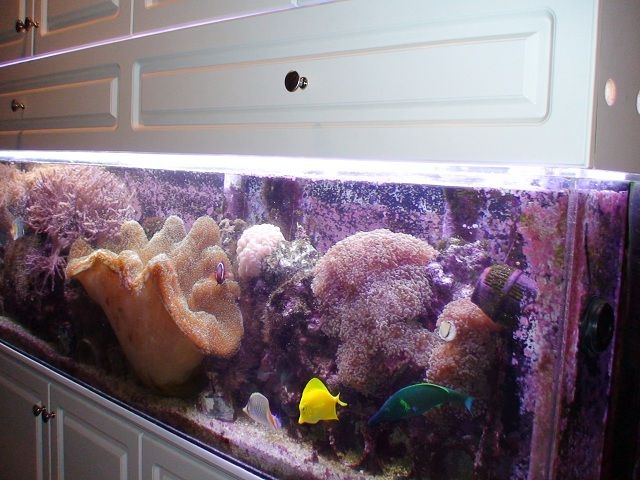 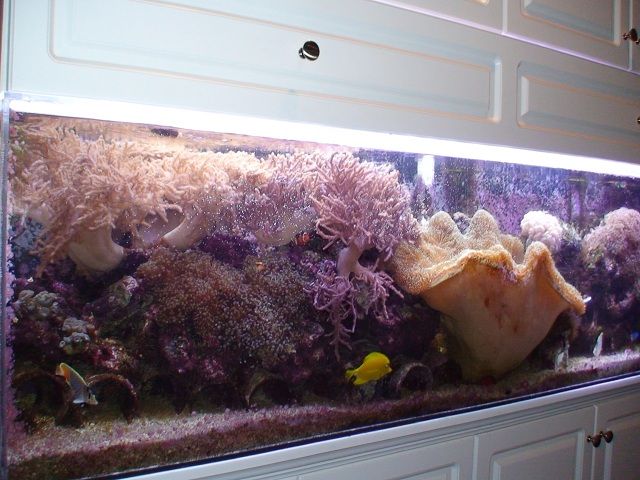 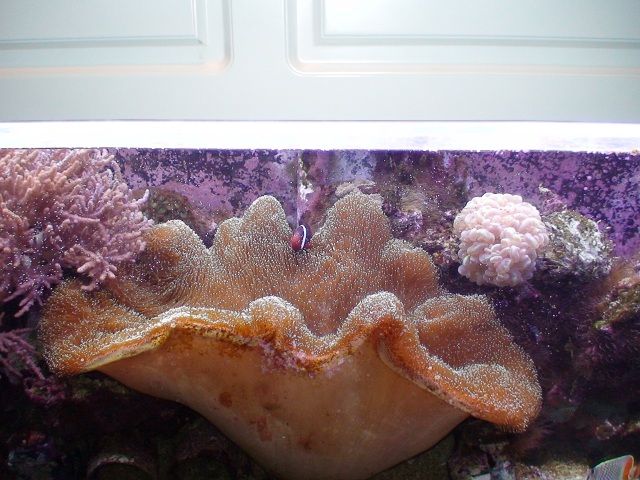 As you can see, the tank was pretty full with softies and some LPS. I fragged the large toadstool and still have a smaller version of it in my downstairs tank, which was set up about a year later. And that bubble coral and frogspawn have been fragged many times as well. Same with the colt coral and sinularia. Might not be visible in these pics, but also have green mushrooms and green palys, which I keep selling or give away. I still have some of the original fish including the Yellow Tang (10+ years old), Dwarf Flame Angel, Flame Hawkfish and Cinnamon Clownfish. I sold the Green Bird Wrasse. I added a couple Pearlscale Butterfly fish, and a Lawnmower Blenny just before these pics. The tank was also full of Aiptasia, but the Pearlscales completely decimated them…, although took about 4 or 5 months. I still have them as well, one in each of my tanks. And they don’t bother my corals either. I had T5’s for lighting. Water flow was handled by a couple Koralias and a closed loop system (no longer used). The tank was also a big chore to clean, as it was full of algae and detritus on the rocks and sand. Nitrates were as high as 100 ppm! I wasn’t measuring phosphates at that time, but I know they were high, too. Probably a classic example of old tank syndrome. Fish didn’t seem to mind, though, and the softies and LPS were doing OK as well. Next, I will describe my sump. But feel free to comment anytime if you wish.
__________________
Reef Pilot's Undersea Oasis: http://www.canreef.com/vbulletin/sho...d.php?t=102101 Frags FS: http://www.canreef.com/vbulletin/sho...d.php?t=115022 Solutions are easy. The real difficulty lies in discovering the problem. |
|
#3
|
|||||
|
|||||
|
Wow walter what a transformation! It looks nothing like it did then. You really stepped it up from what it was!
|
|
#4
|
|||||
|
|||||
|
Thanks, Nick. It didn't transform overnight, that's for sure, and lots of lessons learned along the way. Before I start showing my current tank, I will try to step through the changes, and some of my challenges.
__________________
Reef Pilot's Undersea Oasis: http://www.canreef.com/vbulletin/sho...d.php?t=102101 Frags FS: http://www.canreef.com/vbulletin/sho...d.php?t=115022 Solutions are easy. The real difficulty lies in discovering the problem. |
|
#5
|
|||||
|
|||||
|
Awesome, I'm sure there will be a lot to learn in this thread!
|
|
#6
|
|||||
|
|||||
|
Do your pearlscales eat pellet or flake?
__________________
-- Tony My next hobby will be flooding my basement while repeatedly banging my head against a brick wall and tearing up $100 bills. Whee! |
|
#7
|
|||||
|
|||||
|
They eat everything, pellet, flake, frozen, just like all the other fish. Having said that, I did have to train them in the QT, first frozen mysis, then freeze dried and finally pellets. But they are much easier to keep and hardier than a Copperband which I also had. And you can keep more than one in the same tank (unlike Copperbands). However, over time they did quarrel more and more, and finally separated them when I set up a 2nd tank downstairs.
__________________
Reef Pilot's Undersea Oasis: http://www.canreef.com/vbulletin/sho...d.php?t=102101 Frags FS: http://www.canreef.com/vbulletin/sho...d.php?t=115022 Solutions are easy. The real difficulty lies in discovering the problem. |
|
#8
|
|||||
|
|||||
|
It is a 30g acrylic sump, in the basement under the stairwell, just below the upstairs tank.
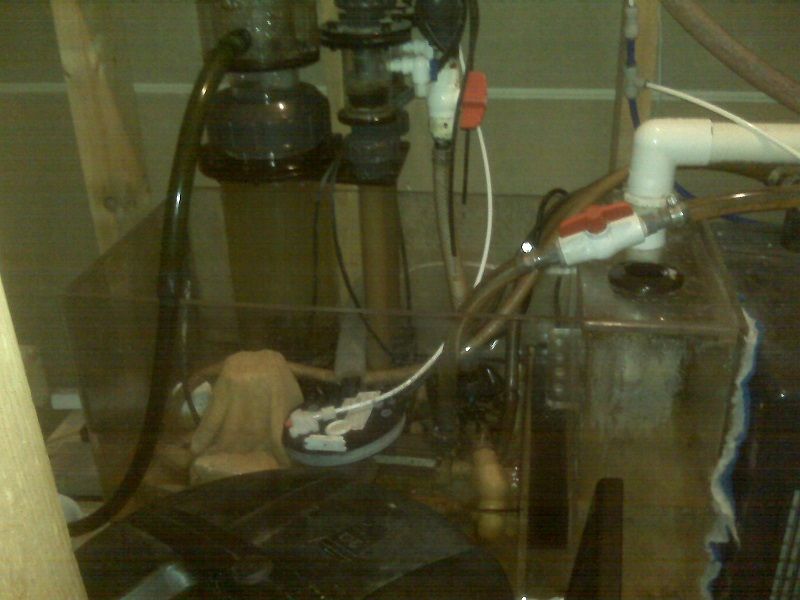 The drain goes into an input chamber with a couple baffles that holds a sponge filter and flows into the main chamber with the skimmer. The top does lift up, and I tried using a filter sock, but it was pita to clean all the time, and was much easier just to remove and squeeze out the sponge every few days. If the sponge plugs (as when away on vacation), it just lifts between the baffles and the water flows by. The return pump was a Mag 18, and had to push water up about 12 feet or so, into the display tank upstairs. Needless to say, flow was considerably less than 1800 gph. I did measure it at the top once, and I think it was less than 200 gph at that point. Initially there was no ATO, and had to manually top off the sump on a daily basis with RO water from a bucket. There was a line coming down from the RO (no DI) system upstairs under the kitchen sink, which was used to fill the top off bucket and the water change barrel. Needless to say, I did not like the constant attention this required, so I obtained a double float control from Canadian Springs (who maintained the RO system at the time) and connected it directly to the RO line to serve as my ATO. Worked pretty good and kept the water level constant for the skimmer. I honestly don’t know how the previous owner put up with the manual system for 10 years.
__________________
Reef Pilot's Undersea Oasis: http://www.canreef.com/vbulletin/sho...d.php?t=102101 Frags FS: http://www.canreef.com/vbulletin/sho...d.php?t=115022 Solutions are easy. The real difficulty lies in discovering the problem. |
|
#9
|
|||||
|
|||||
|
I could never find out exactly what brand name or model skimmer this was. No ID plate and could not find a good match with internet searches. Might have been partially DIY.
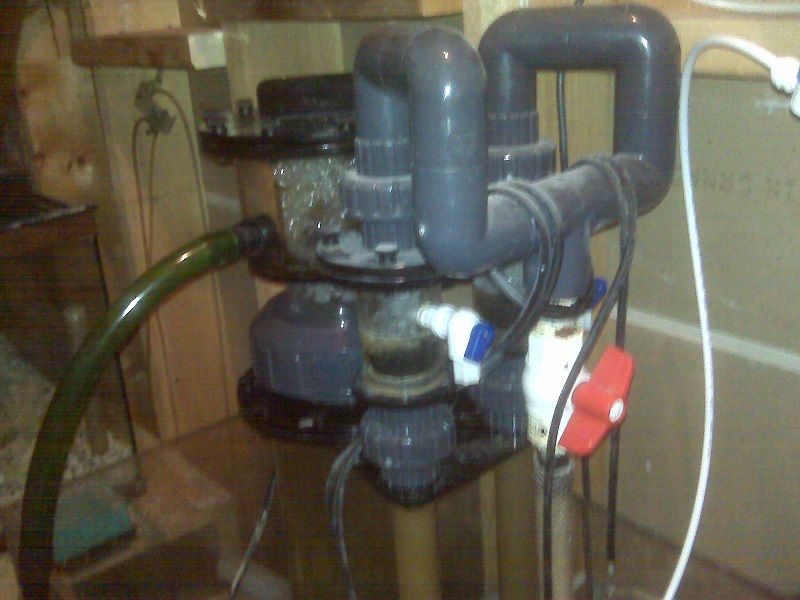 It was a dual beckett skimmer, with a gate valve outlet and a fine mesh cheese type cloth to catch the micro bubbles. The pump was a Sedra 7000 (700gph), hardly enough power to drive the two becketts. But it did produce some skimmate, and I had to occasionally empty the collection jug. What I discovered afterwards, when I took apart the pump for some cleaning, is that it had a pinwheel impeller with an air intake at the input. I guess between the pinwheel and the becketts, it did work, to some degree. Definitely not something you would ever buy off the shelf, though.
__________________
Reef Pilot's Undersea Oasis: http://www.canreef.com/vbulletin/sho...d.php?t=102101 Frags FS: http://www.canreef.com/vbulletin/sho...d.php?t=115022 Solutions are easy. The real difficulty lies in discovering the problem. Last edited by Reef Pilot; 11-06-2013 at 12:13 AM. |
|
#10
|
|||||
|
|||||
|
This is my tank overflow. Definitely no bean animal, herbie or durso... Just one drain at the bottom flowing down to the sump in the basement. No noise, though, but the flow is not that high. And the top of the overflow has a styrofoam cover and is inside a closed canopy. I clean the teeth at the top with a toothbrush every few months, to prevent any algae build-up. It's been this way for 13 years, and never a problem.
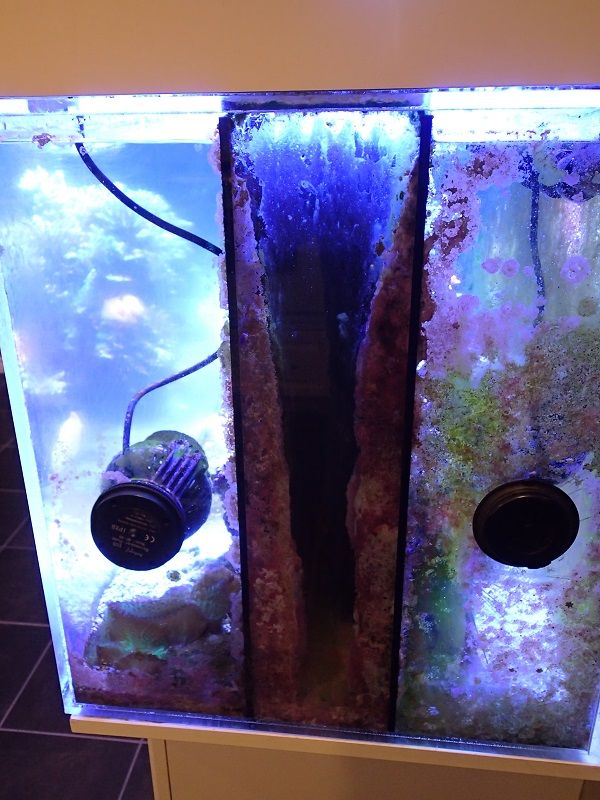
__________________
Reef Pilot's Undersea Oasis: http://www.canreef.com/vbulletin/sho...d.php?t=102101 Frags FS: http://www.canreef.com/vbulletin/sho...d.php?t=115022 Solutions are easy. The real difficulty lies in discovering the problem. |